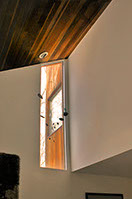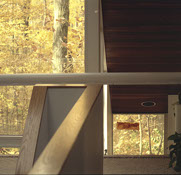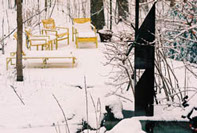
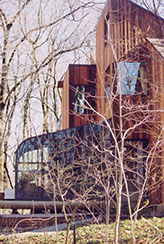
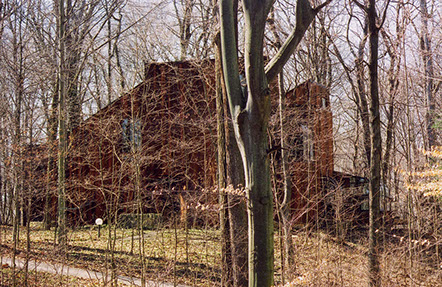
The California Redwood House In The Ohio Sugar Maple Woods

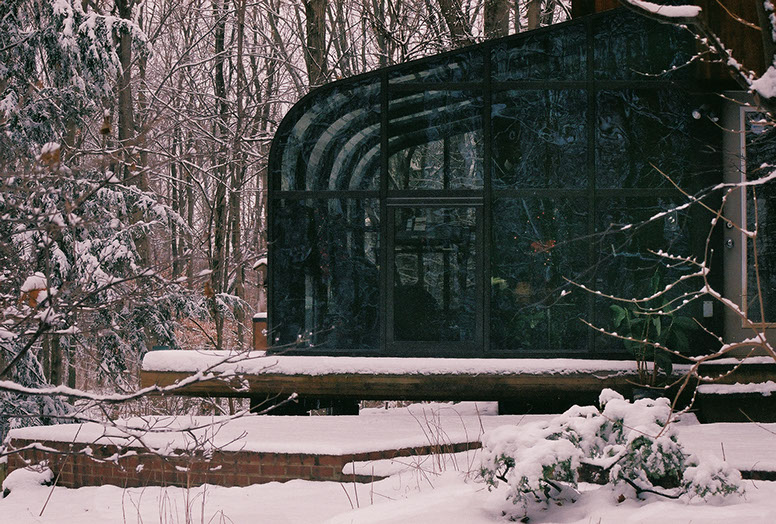
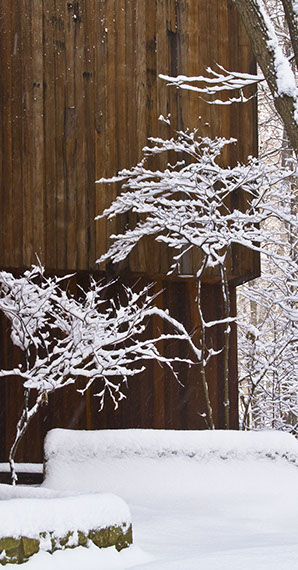
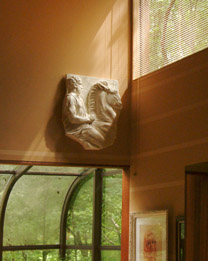
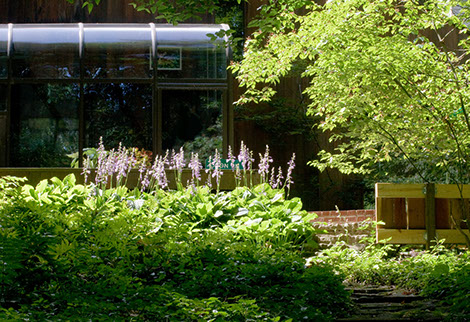
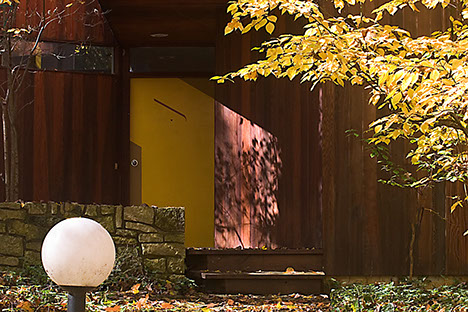
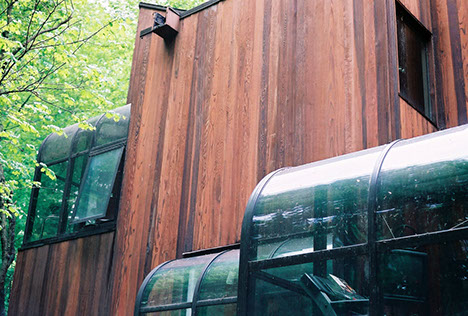
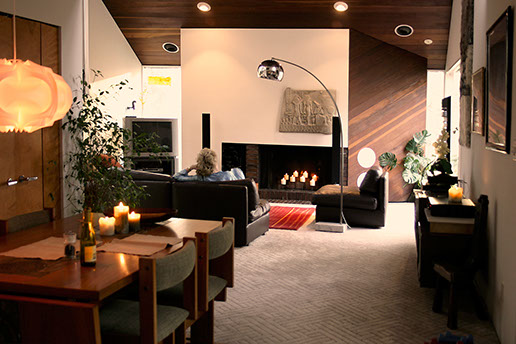
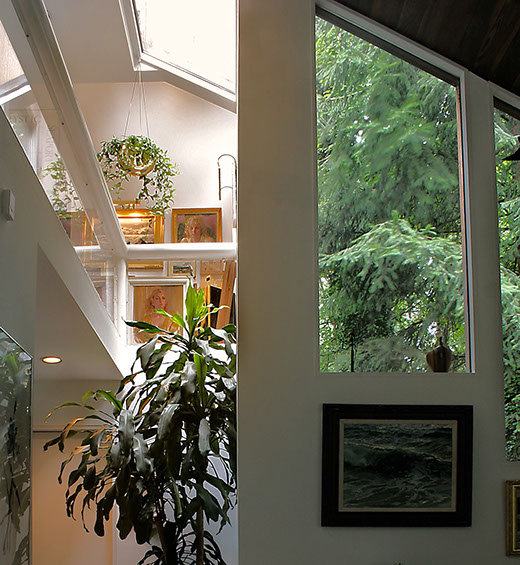
A native Ohio AIA architect and an émigré artist from California (yours truly) got together to design this California redwood house in an Ohio sugar maple woods, and came up with something that is as sculptural as architectural, thanks more to Gwathmey than Wright.
Its main secret is contrast, as can only happen through modern simplicity – two stories of simple flat planes playing against unexpected masses of just curving glass, against decisively angular rooflines and cantilevered upper rooms. Pure forms, pure lines, geometric (Hemingway would say “honest”) – no eaves outside, no baseboard or rococo molding inside, not even around doors or windows. And the textures – weathered, stained redwood against arching glass masses; those against geometric red brick, the patios, against ragged flagstone and exposed aggregate concrete paths. And the intricacy of dense woods, lacy Spring leaves and strong-willed trunks, the monolithic gold wall of Fall sugar maples, playing against these simple structural forms. That’s outside.
Inside, the simple pure white or taupe wall masses contrasting with an oiled redwood shed-angled ceiling or an angled redwood wall. And the walls contrasting with the windows, not a standard store-bought one in the house, from peeps, to slits, to huge view window, to a bank of windows 2 stories tall and angled on into the roof, where a string of skylights continues the line, and the unmitigated glass of the three solariums, window-sized to room-sized. Strategically placed to maximize and optimize the view outside and to merge the inside with the outside, a favorite Richard Neutra device, all the windows are themselves design elements laid against the wall masses, the whole being composed like a Klee painting, in turn painted upon by long roving shafts of window light And now the contrast of the 2 story unbroken hall wall rising like the monolith in “2001,” with a designed-for-the-spot array of modernist sculpture, with the floating stairway and balcony, where you have a straight-line view into the great room and, through the huge windows, into the woods. And if the simple redwood planes outside are backdrops for forest trees, the simple white planes inside are sympathetic backdrops for the boldest foliage – corn plants, philodendrons, – and both avant-garde abstract and academic realistic paintings, illuminated by gallery track lights. Everything -- walls, windows, woods, kinetic shadows and sunlight upon the leaves and walls, inside and out -- contrast and counterpoint.
Of a kind of architecture more surely designed as a stage for tree trunks and dancing leaves and shadows, and snow, and art, than anything Frank L. Wright designed, and more dramatic than, if not as cozy as, a Kincaid cottage or the Seven Dwarfs’ hut, this house was created for just these Ohio deciduous woods, not for any city or even suburbs, where it would be an abomination. It does not exist for itself; it exists for the woods. It took audacity, and maybe a little fresh-from-California newness to Ohio, to create such a place.
And so it happened that in the Ohio woods a new and very limited style of architecture was conceived: distant homage to Neutra, immediate homage to Ohio barns and Gwathmey, and Arby greenhouses. Kime-Gwathmey-Arby school of architecture. You're looking at the only example of it.
So first you see the trees and then through that latticework you see the house. But the house isn’t simply abandoned to the woods, like the standard “house in the woods.” It’s landscaped, to complement the woods, while at the same time complementing the house, a neat trick. From the floating greenhouse you see the hosta garden, hardly an urban view, defined by two brick patios, triangular again, and the sculptural fences and the vibernums and pagoda dogwood trees, and at the apex of the garden a small reflecting pool and the weathered iron sculpture-fountain, triangular and tubular elements, and beyond it, open into the woods, actually in the woods, a lounging deck. Then, viewed best from the deck off the great room or from the all-glass wing, you see the managed woods – landscaped like a park -- with sloping meadows and fields of variegated lamium with many clusters of fern and variably speckled with residual wild geranium, and, even up close to the house, clumps of tall jack-in-the-pulpit, plus wood poppies, merrybells and Solomon’s seals, bugbane, scattered trilliums, stands of may apple, and – contrast again – large laboriously ensconced hemlocks, all blending into the aboriginal woods, and beyond, gentle stream. Deer are out there grazing or cavorting, and the raccoons can be inveigled down from their trees to sip from the reflecting pool and check what you’re having for dinner. And there are squirrel circus acts, and the chipmunks, and sometimes an opossum, aloof but curious. Cardinals, chickadees, gold finches, hummingbirds, of course, but especially woodpeckers.
So the Nov 2006 HouseTrends magazine featured this house. And the Fed-X man comes to the door and rather gasps, “Ah ain’t seen NUTHIN’ lie-yak they-at!”
This house is almost too photogenic.
